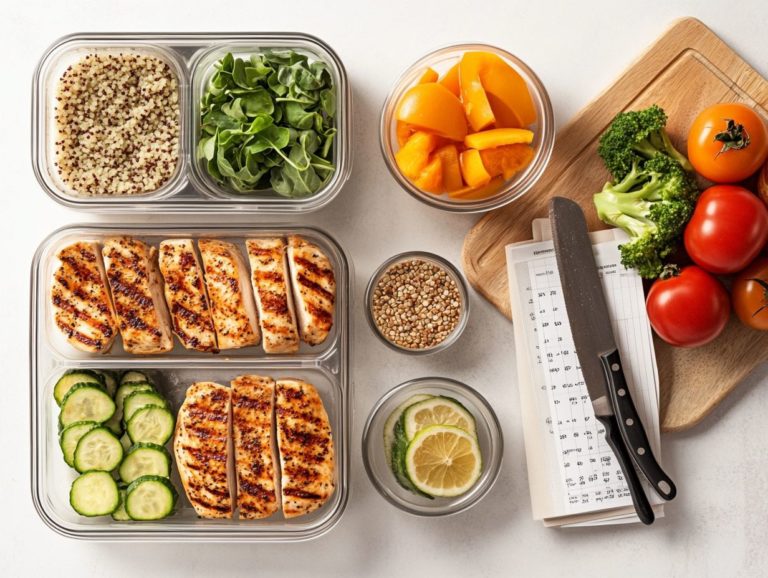Portion Control: Understanding Serving Sizes
Portion control is an essential component of a healthy lifestyle, yet many find themselves grappling with what an appropriate serving size truly looks like.
This article delves into the concept of portion control, clarifying its definition and importance while offering practical tools and techniques for measuring serving sizes effectively.
It explores the myriad benefits of mastering this skill, highlights common pitfalls to steer clear of, and provides actionable tips to seamlessly integrate effective strategies into your daily routine.
Whether your goal is weight management or simply adopting healthier eating habits, grasping the principles of portion control is vital for your success.
Contents
- Key Takeaways:
- What is Portion Control?
- How to Measure Serving Sizes
- Benefits of Portion Control
- Common Mistakes to Avoid
- Tips for Practicing Portion Control
- Frequently Asked Questions
- What is portion control and why is it important?
- How do I determine the correct portion size for my meals?
- What are some tips for practicing portion control at home?
- How can I practice portion control when eating out at restaurants?
- Is it okay to occasionally indulge in larger portion sizes?
- How can understanding serving sizes help me maintain a healthy weight?
Key Takeaways:

- Portion control is understanding the right amount of food to eat, which is crucial for maintaining a healthy weight and preventing chronic diseases.
- Measuring serving sizes can be tricky, but using tools like measuring cups and portion plates can help.
- Practicing portion control can lead to weight loss, improved digestion, and better overall health. It’s important to avoid overestimating serving sizes and using portion distortion to stay on track.
What is Portion Control?
Portion control is an essential aspect of healthy eating that involves managing serving sizes to achieve optimal calories you eat and nutritional balance. By understanding how much food you consume, you can better support weight management, prevent obesity, and enhance your overall wellness.
Following guidelines set by respected authorities like the U.S. Food and Drug Administration (FDA) and the Dietary Guidelines for Americans gives you the power to cultivate healthier eating habits. With informed choices based on Nutrition Facts labels, which show you important information about the food you eat, you can adopt a more conscious approach to your food and meal selections, elevating your eating experience to one that truly nourishes your body.
Definition and Importance
Portion control is the art of managing the sizes of your food servings to help you avoid overeating and maintain a balanced diet. This essential strategy plays a pivotal role in weight management, encouraging you to consume just the right amounts of nutrients your body craves without the burden of excess calories.
By embracing and implementing portion control, you can significantly lower your risk of obesity, an issue that s become a pressing public health concern. It s not merely about opting for smaller plates; it s about cultivating a mindful eating habit that prioritizes nutrition while aligning with your lifestyle needs.
With effective portion control, you give yourself the power to make healthier choices, enhancing your overall wellness and fostering a sustainable relationship with food.
How to Measure Serving Sizes
Accurately measuring serving sizes is crucial for effective portion control, and it encompasses a range of tools and techniques to help you track food consumption and manage portions with precision.
By mastering the interpretation of Nutrition Facts labels, you can easily identify the recommended serving sizes for different food items. With this knowledge, you can confidently make healthier eating choices that align seamlessly with your dietary goals.
Tools and Techniques

Utilizing tools and techniques such as measuring cups, food scales, and visual cues can significantly elevate your ability to practice portion control with precision. These resources offer a more accurate means of assessing the appropriate amounts of food, ultimately fostering healthier eating habits.
Familiarizing yourself with standard portion sizes using visual cues like comparing a serving of meat to the size of a deck of cards can give you the power to make informed decisions during mealtimes. For instance, a digital food scale not only tracks weight but also counts calories, allowing you to grasp the nutritional content of your meals more clearly.
By incorporating these effective measurement strategies, you can maintain a balanced diet without the sensation of deprivation.
Start measuring your portions today and take the first step toward healthier eating habits!
Embrace portion control today and unlock the key to a healthier, happier you!
Benefits of Portion Control
The advantages of portion control reach well beyond simple calorie counting it helps you eat healthier, supports effective weight management, and plays a crucial role in overall health and wellness.
By embracing portion control, you can confidently navigate your food choices, savor a rich diversity of meals, and seamlessly incorporate a vibrant array of fruits and vegetables into your diet. This mindful approach not only helps prevent overconsumption but also nurtures a sustainable lifestyle that you can maintain with ease.
Weight Management and Health Benefits
Effective weight management stands out as one of the primary health benefits of practicing portion control, allowing you to maintain a healthy weight while enjoying a variety of foods.
By being mindful of serving sizes, you can significantly reduce the risk of obesity, fostering an approach that champions moderation over deprivation. Portion control enhances your understanding of nutrition facts, which is the information about the nutrients and calories in food. This knowledge deepens your awareness of caloric intake and nutritional values, ultimately guiding you toward healthier choices.
This technique supports balanced eating habits, making it easier for you to eat a variety of nutrients in your diet. Embracing this holistic approach not only helps you achieve your desired weight but also promotes overall health by minimizing the risk of chronic diseases associated with excessive calorie consumption.
Common Mistakes to Avoid
You should prioritize avoiding common pitfalls in portion control, such as overestimating serving sizes and succumbing to portion distortion. This practice is crucial for achieving effective healthy eating and maintaining optimal weight management.
Overestimating Serving Sizes and Portion Distortion

Overestimating serving sizes and falling victim to portion distortion thinking you need more food than you really do are widespread issues that can undermine your portion control strategies.
These misconceptions often arise from cultural norms and marketing tactics that celebrate larger quantities as the gold standard. For example, you might find yourself thinking that a plate overflowing with food is perfectly normal, even when it far exceeds the recommended guidelines.
This misjudgment can lead to consuming more calories than intended, ultimately affecting your health and weight management goals. To tackle these common traps, it helps to get acquainted with accurate serving sizes through measuring cups or food scales.
Opting for smaller plates and bowls can cleverly trick your mind into feeling satisfied with less food, encouraging a more mindful approach to your eating habits.
Tips for Practicing Portion Control
Ready to take control? Here are some essential tips! Embracing practical tips for portion control can transform your eating habits and elevate your overall well-being, whether you re at home or enjoying a meal out. These strategies promote mindful eating, allowing you to stay attuned to the quantities of food you consume.
This heightened awareness gives you the power to make healthier choices, whether you re savoring a home-cooked meal or indulging at a restaurant.
Practical Strategies for Portion Control
Employing practical strategies like meal planning, using smaller plates, and understanding calories can significantly enhance your ability to maintain portion control.
By adopting these methods, you can navigate your eating habits with increased ease and mindfulness. For instance, embracing meal preparation not only helps you organize your ingredients more effectively but also gives you the chance to create balanced meals that align with your nutritional goals.
Practicing calorie awareness gives you the power to make informed food choices, nurturing healthier eating habits over time. Incorporating techniques such as visual portioning and mindful eating can further strengthen your commitment to healthier living.
Ultimately, these strategies provide you with the essential tools for sustainable wellness and mindful consumption.
Frequently Asked Questions
What is portion control and why is it important?

Portion control is the practice of managing how much food you eat in one sitting. It’s key to enjoying your meals without overeating.
How do I determine the correct portion size for my meals?
Your portion size can vary based on your needs. A good rule of thumb is to use your hand as a guide.
One serving of protein should be about the size of your palm. For carbohydrates, aim for the size of your clenched fist.
What are some tips for practicing portion control at home?
Measure and portion your food before eating. Using smaller plates can also help trick your brain into thinking you’re eating more.
Eat slowly and pay attention to your body’s signals for fullness.
How can I practice portion control when eating out at restaurants?
Split a dish with a friend or ask for a to-go container for leftovers. Request dressings and sauces on the side for better control.
Choose healthier options on the menu whenever possible.
Is it okay to occasionally indulge in larger portion sizes?
Yes, indulging sometimes is fine as long as you balance it with healthier choices. It’s all about moderation and finding what works for you.
How can understanding serving sizes help me maintain a healthy weight?
Understanding serving sizes aids in managing your calorie intake, or how many calories you consume. Practicing portion control makes it easier to avoid excess calories and choose wisely.






